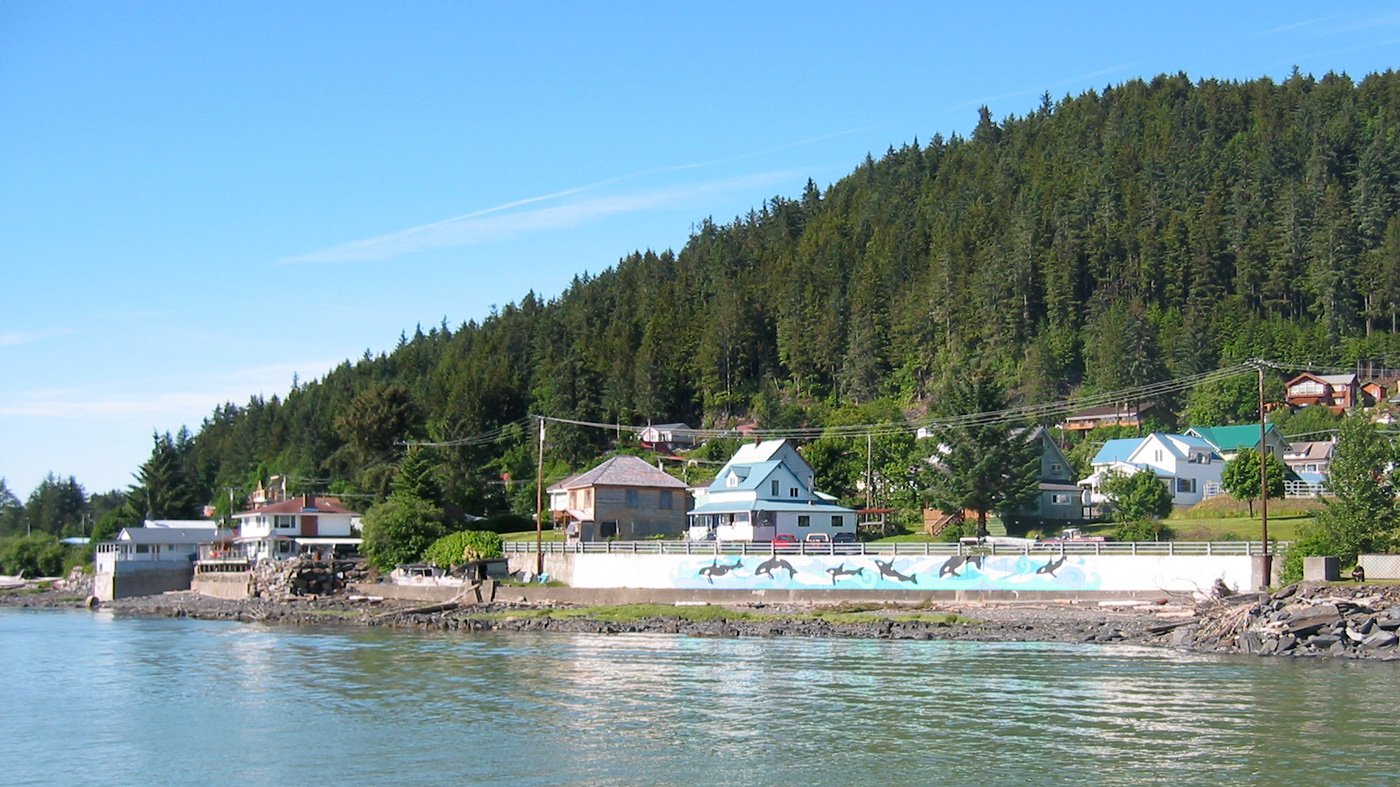Getting Around Foreign Town
I’m pleased to have published a collection of Historic Wrangell Maps! One question I’ve received is about the “Foreign Village.” It’s a neighborhood in Wrangell you can still visit today with a lot of history!
(Image credit: James Crippen).
The gate protecting the north side of Fort Wrangel used to stand here. Today, it’s one of the ways into Fort Street. (Image Credit: Killian Booker on Google Street View)
THE BEGINNING
Foreign Town is one of the first sites you’ll see from City Dock. begins on the northern side of the US Post Office property, and runs along the coast. Today, it is a neighborhood with some very nice homes.
It’s hard to know exactly when Foreign Town began. It’s not referenced in the 1869 Bombardment narratives. It likely began in the mid-1870s when the Cassiar Gold Rush brought outsiders to Wrangell. Bonnie Demerjian’s Wrangell: Images of America describes who lived there:
“The area of Wrangell north of the fort was originally called Foreign Town. In this section lived Alaska Natives from other tribes and those Stikine Tlingit who had married outside the tribe. The fort was surrounded by a stockade with gates on both the north and south offering the only access through the town.”
The garrison walls of Fort Wrangel provided some separation from the village of Ḵaachx̱ana.áakʼw to the south. This also gave Foreign Town its own identity.
POPULATION GROWS
The Cassiar Gold Rush brought people like never before. In 1876, over 100 men in Fort Wrangel signed a petition describing the swelling population:
The fixed population of Fort Wrangel is about 800, i.e., 300 whites and 500 Indians, independently of which a large foreign Indian trade is continually kept up, from 500 to 700 foreign Indians constantly visiting Fort Wrangel for the purpose of trading and proceeding to the mines, many of whom remain at and about Fort Wrangel during the summer.
Reverend S. Hall Young arrived in 1878 and wrote the most detailed description of Foreign Town:
Great gates of split logs swung on huge hinges gave egress on opposite sides of the “Foreign Village… With the advent of the white soldiers, miners, and traders, the Indians from all the tribes of the Archipelago came pouring into Fort Wrangell. They were not not allowed by the Stickeens to build even their bark shacks within the harbor, but camped in what we called the Foreign Town, up the beach towards the point of the island… They built shacks of bark or split planks, and some of them whip-sawed lumber and erected rude cabins… The Fort lay directly between the Stickeen town and the foreigners, and the only way from one to the other when the tide was up was through the gates to the Fort.
Presbyterian missionary Amanda R. McFarland eyed an opportunity to find converts among the people of Foreign Town. In July 1878, she wrote to Sheldon Jackson:
There is a lot of wild Indians living up the Beach—that I have never been able to induce to come into school… I felt distressed about them. So I went up there, rented an old log house on the point & opened a school. I have from 45 to 60 in attendance. I teach them from the blackboard.
CONFLICT
The rise of Foreign Town placed Fort Wrangel between two Indigenous communities. In 1879, John Muir observed:
“Indians, mostly of the Stickeen tribe, occupied the two ends of the town, the whites, of whom there were about forty or fifty, the middle portion; but there was no determinate line of demarcation, the dwellings of the Indians being mostly as large and solidly built of logs and planks as those of the whites.”
Shortly after John Muir’s visit, years of simmering tensions in Foreign Town boiled over. The dispute pitted Tlingit followers of the Christian missionaries against Indigenous outsiders importing, manufacturing, and selling liquor. People on both sides of the conflict were killed. In the aftermath, Foreign Town was taken over. George Thornton Emmons wrote:
“Colonel Crittenden, deputy collector of customs, who had organized the native police force at Wrangell, had the ‘guest houses’ destroyed, and fenced in the area for a garden. The natives resented this, and for a time none came to Wrangell to trade.”
Crittenden became a prolific gardener and lived in Wrangell for decades. He frequently offered guests and visitors fresh vegetables from his garden. To this day, the street nearby is called Crittenden Avenue.
Around the turn of the century, the Alaska Sanitary Packing cannery went up on the point now occupied by the Alaska Marine Highway Ferry Terminal. According to Brian G. Shellum in Buffalo Soldiers in Alaska, the cannery housed Chinese cannery workers in Foreign Town.
FORT STREET LIVES ON
Though it’s small, you can see a footprint of Foreign Town by visiting Fort Street in Wrangell. It’s easy to miss. You’ll access it from the north side of the US Post Office. That’s where the heavy gate Reverend Young saw all those years ago stood. Go on foot. The road is short and narrow.
The name “Foreign Town” is not commonly used today, as far as I know. I’d love to hear about more references to it in other stories.
I have a lot of fond memories of this part of Wrangell. It’s a beautiful spot near the water with a good view of what’s going on at the waterfront. I knew people who lived here in the past, like my late sister Jan Churchill and her neighbor “Hippie Chris” Cawthorne. This was a fun spot to hang out and shoot the breeze.

